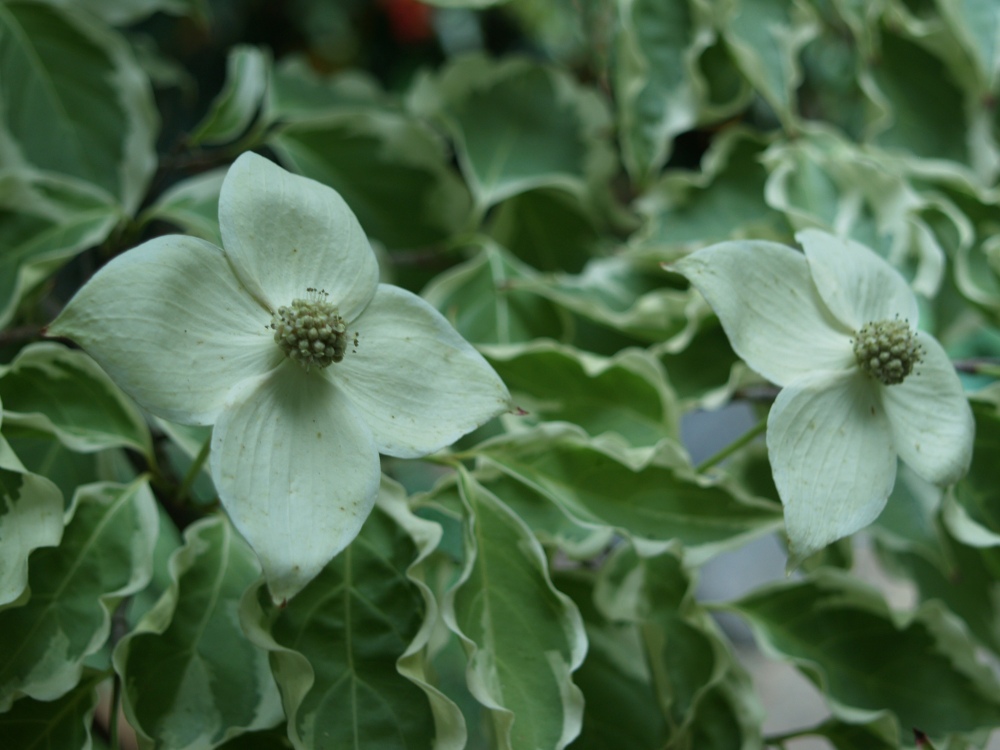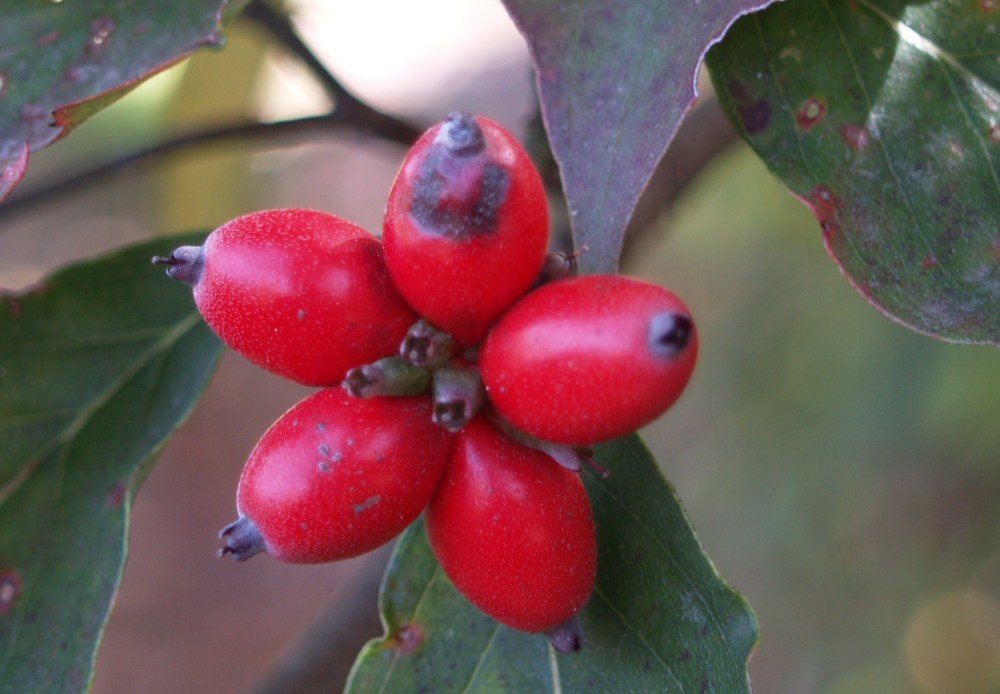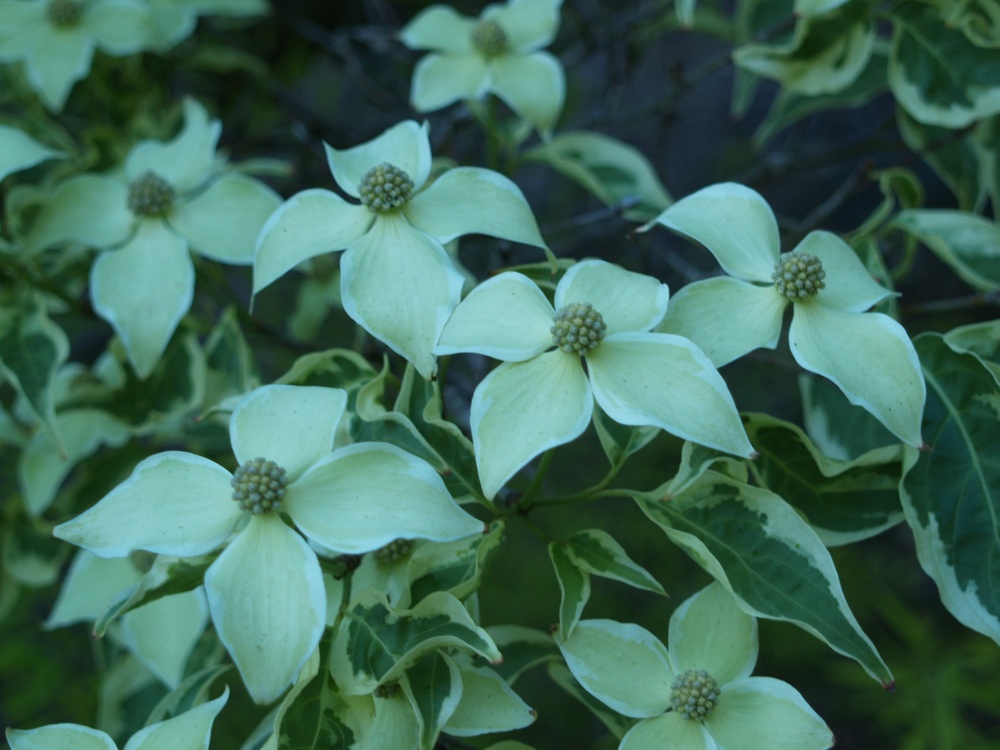In May, I was quite pleased to finally have flowers on the ‘Samaritan’ Chinese dogwood (Cornus kousa ‘Samaritan’ below). The dogwood, with excellent green and white variegation, is planted along stone steps that descend from one patio to another between two small ponds in the upper garden. The tree is prominently viewed from the kitchen window, and though it has grown vigorously to at least fifteen feet, the absence of flowers has been a bit disappointing.
‘Samaritan’ has been partially shaded by a tall threadbranch cypress (Chamaecyparis pisifera) and a wide spreading Fernleaf Japanese maple (Acer japonicum ‘Aconitifolium’), and while this has not slowed its growth, it has evidently inhibited flowering. To my eye there appears to be sufficient light, but as is often the case, my vote doesn’t count.
Now, I am supposing that the dogwood has grown tall enough that its upper branches reach more sunlight,and so there were a few scattered flowers in late spring. This does not explain why there were also flowers on some lower branches, but I’m reaching for an explanation, and this is as good as I can figure.
While flowers of the native American dogwood (Cornus florida) turn to clusters of red berries in early autumn (above), the single fruits of the Chinese dogwood are the size of a small strawberry, and similarly colored (below). The fruits are said to be edible, but either I have not sampled one with the proper degree of ripeness, or they are so bland that one should question why they are considered edible.
I notice that the fruits of Chinese dogwoods disappear once they are ripe, so birds must consider them edible, though also I notice that some just fall to the ground, so it seems safe to venture that they are not highly prized.
Before ending it should be noted that Chinese dogwoods (and hybrids that cross the Chinese and American dogwoods) are resistant to the diseases that commonly trouble our native, and for the gardener who desires dogwood flowers for more than a few weeks in April, planting natives, hybrids, and Chinese dogwoods will extend flowering from mid April (in my Virginia garden) into early June.
Regular readers will not be surprised that I have planted several colors of the native dogwood, several hybrids, and a handful of varied cultivars of Chinese dogwoods. Of variegated Chinese dogwoods, I judge the upright habit of ‘Samaritan’ superior to the shrub-like ‘Wolf Eyes’, though ‘Wolf Eyes’ flowers prolifically (above).
Lovely! Both the tree and your photos. Thank you for sharing them!
To choose only one or the other I would select our native American dogwood since it has combined attributes that other trees cannot match. But, I am blessed with more space and more choices so that I can enjoy flowers over months, not weeks.
Reblogged this on Old Herbaceous and commented:
Dave in Virginia has posted the most beautiful photos of his Cornus Kousa “Samaritan” on his blog. I have native American dogwoods in my garden but his pictures are enough to inspire longing for this Chinese dogwood.
I have recently planted a 6’ samaritan and would love to know the growth rate! Also would love to see it at 15’ as its pretty new to Chicago.
My Samaritan grew much faster than other dogwoods. It is probably 20 feet tall, the mature height that it’s supposed to reach. Samaritan has a much more upright habit than other dogwoods, but it’s an outstanding tree.
Thanks for your reply dave! Love this site!.. So your Samaritan matured in 4-5 years? My Samaritan is about 6 ft now. Recently planting in may, it’s now June and I still find myself watering a LOT! even after rain. Hopefully this will slow down a bit once it gets established lol.
Kousa dogwoods are prone to wilting in the summer sun, looking very dry even when they’re not. I don’t think my Samaritan hit full size quite this quickly, but it grows much more quickly than most dogwoods. Certainly, here in Virginia we have a longer growing season than you do, but most of the growth is the initial spring growth that should be varied only with soil fertility and moisture. I do not fertilize anything, so whatever growth a plant gets it’s on its own.